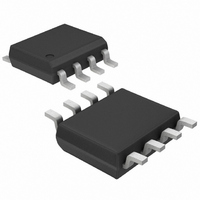MAX1243BESA+ Maxim Integrated Products, MAX1243BESA+ Datasheet - Page 6

MAX1243BESA+
Manufacturer Part Number
MAX1243BESA+
Description
IC ADC 10BIT SERIAL 8-SOIC
Manufacturer
Maxim Integrated Products
Datasheet
1.MAX1243BCSA.pdf
(12 pages)
Specifications of MAX1243BESA+
Number Of Bits
10
Sampling Rate (per Second)
73k
Data Interface
MICROWIRE™, QSPI™, Serial, SPI™
Number Of Converters
1
Power Dissipation (max)
471mW
Voltage Supply Source
Single Supply
Operating Temperature
-40°C ~ 85°C
Mounting Type
Surface Mount
Package / Case
8-SOIC (0.154", 3.90mm Width)
Number Of Adc Inputs
1
Architecture
SAR
Conversion Rate
73 KSPs
Resolution
10 bit
Input Type
Voltage
Interface Type
Serial
Voltage Reference
External
Supply Voltage (max)
5 V
Maximum Power Dissipation
471 mW
Maximum Operating Temperature
+ 85 C
Mounting Style
SMD/SMT
Minimum Operating Temperature
- 40 C
Lead Free Status / RoHS Status
Lead free / RoHS Compliant
The MAX1242/MAX1243 use an input track/hold (T/H)
and successive-approximation register (SAR) circuitry
to convert an analog input signal to a digital 10-bit out-
put. Figure 3 shows the MAX1242/MAX1243 in their
simplest configuration. The MAX1242/MAX1243 convert
input signals in the 0V to V
T/H acquisition time. The MAX1242’s internal reference
is trimmed to 2.5V, while the MAX1243 requires an
external reference. Both devices accept external refer-
ence voltages from 1.0V to V
requires only three digital lines (SCLK, CS, and DOUT)
and provides an easy interface to microprocessors
( Ps).
The MAX1242/MAX1243 have two modes: normal and
shutdown. Pulling SHDN low shuts the device down and
reduces supply current below 10µA (V
pulling SHDN high or leaving it open puts the devices
into operational mode. A conversion is initiated by
pulling CS low. The conversion result is available at
DOUT in unipolar serial format. The serial-data stream
consists of a high bit, signaling the end of conversion
(EOC), followed by the data bits (MSB first).
Figure 4 illustrates the sampling architecture of the ana-
log-to-digital converter’s (ADC’s) comparator. The full-
scale input voltage is set by the voltage at REF.
+2.7V to +5.25V, Low-Power, 10-Bit
Serial ADCs in SO-8
6
______________________________________________________________Pin Description
_______________Detailed Description
_______________________________________________________________________________________
PIN
1
2
3
4
5
6
7
8
NAME
SHDN
DOUT
SCLK
GND
REF
V
AIN
CS
DD
Positive Supply Voltage: +2.7V to +5.25V
Sampling Analog Input, 0V to V
Three-Level Shutdown Input. Pulling SHDN low shuts the MAX1242/MAX1243 down to 15µA (max)
supply current. Both MAX1242 and MAX1243 are fully operational with either SHDN high or floating.
For the MAX1242, pulling SHDN high enables the internal reference, and letting SHDN float disables
the internal reference and allows for the use of an external reference.
Reference Voltage for Analog-to-Digital Conversion. Internal 2.5V reference output for MAX1242;
bypass with a 4.7µF capacitor. External reference voltage input for MAX1243, or for MAX1242 with the
internal reference disabled. Bypass REF with a minimum of 0.1µF when using an external reference.
Analog and Digital Ground
Serial-Data Output. Data changes state at SCLK’s falling edge. High impedance when CS is high.
Active-Low Chip Select. Initiates conversions on the falling edge. When CS is high, DOUT is high
impedance.
Serial-Clock Input. SCLK clocks data out at rates up to 2.1MHz.
REF
Converter Operation
DD
range in 9µs, including
. The serial interface
DD
Analog Input
≤ 3.6V), while
REF
range
In track mode, the analog signal is acquired and stored
in the internal hold capacitor. In hold mode, the T/H
switch opens and maintains a constant input to the
ADC’s SAR section.
During acquisition, the analog input AIN charges
capacitor C
interval. At this instant, the T/H switches the input side
of C
sents a sample of the input, unbalancing node ZERO at
the comparator’s input.
In hold mode, the capacitive digital-to-analog converter
(DAC) adjusts during the remainder of the conversion
cycle to restore node ZERO to 0V within the limits of 10-
bit resolution. This action is equivalent to transferring a
charge from C
DAC, which in turn forms a digital representation of the
analog input signal. At the conversion’s end, the input
side of C
charges to the input signal again.
The time required for the T/H to acquire an input signal
is a function of how quickly its input capacitance is
charged. If the input signal’s source impedance is high,
the acquisition time lengthens, and more time must be
allowed between conversions. The acquisition time,
t
the signal and the minimum time needed for the signal
to be acquired. Acquisition time is calculated by:
ACQ
HOLD
FUNCTION
, is the maximum time the device takes to acquire
to GND. The retained charge on C
HOLD
HOLD
t
ACQ
HOLD
. Bringing CS low ends the acquisition
switches back to AIN, and C
= 7(R
to the binary-weighted capacitive
S
+ R
IN
) x 16pF
HOLD
Track/Hold
repre-
HOLD











